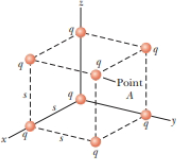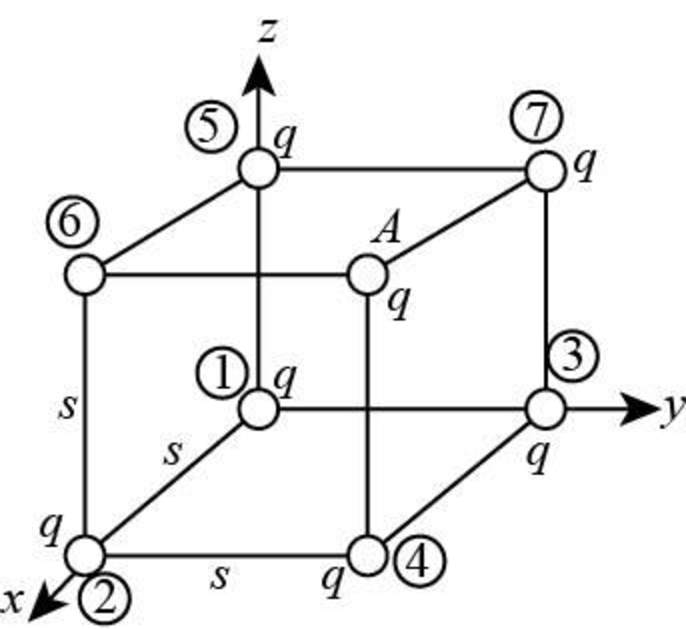
Concept explainers
Eight charged panicles, each of magnitude q, are located on the corners of a cube of edge s as shown in Figure P22.48. (a) Determine the x, y, and z components of the total force exerted by the other charges on the charge located at point A. What are (b) the magnitude and (c) the direction of this total force?
Figure P22.48

(a)
The
Answer to Problem 23.85CP
The
Explanation of Solution
The side of the each cube is
Write the expression for the coulomb’s force law between the two charges
Here,
The charge configuration is as shown in figure below.

Figure (1)
The charges present at the sides are distance
For the net force in
For force due to charge 6 is only in the y-direction
Substitute
The force due to charge 5 and 2 makes an angle
Substitute
Substitute
The charge 1 is
Write the expression for the cosine value of the angle
Write the expression for the force due to charge 1
Substitute
Substitute
Write the expression for the net force in
Substitute
Thus, net force in
From the cubical symmetry the net force in
Thus, net force in
And the net force in
Conclusion:
Therefore, the
(b)
The magnitude of the net force.
Answer to Problem 23.85CP
The magnitude of the net force is
Explanation of Solution
The side of the each cube is
Write the expression for the magnitude of the net force
Substitute
Conclusion:
Therefore, the magnitude of the net force is
(c)
The direction of the net force.
Answer to Problem 23.85CP
The direction of the net force is away from the origin.
Explanation of Solution
There is a force component in
Hence, the net force isn’t along any particular direction rather it has components in all three directions with equal magnitudes and it is pointed away from the origin
Conclusion:
Therefore, the net direction is away from the origin making equal angle with all the three axes.
Want to see more full solutions like this?
Chapter 23 Solutions
Physics for Scientists and Engineers, Technology Update (No access codes included)
- A Two positively charged particles, each with charge Q, are held at positions (a, 0) and (a, 0) as shown in Figure P23.73. A third positively charged particle with charge q is placed at (0, h). a. Find an expression for the net electric force on the third particle with charge q. b. Show that the two charges Q behave like a single charge 2Q located at the origin when the distance h is much greater than a. Figure P23.73 Problems 73 and 74.arrow_forwardIn Figure P24.49, a charged particle of mass m = 4.00 g and charge q = 0.250 C is suspended in static equilibrium at the end of an insulating thread that hangs from a very long, charged, thin rod. The thread is 12.0 cm long and makes an angle of 35.0 with the vertical. Determine the linear charge density of the rod. FIGURE P24.49arrow_forwardA point charge +2Q is at the origin and a point charge Q is located along the x axis at x = d as in Figure P22.11. Find a symbolic expression for the net force on a third point charge +Q located along the y axis at y = d. Figure P22.11arrow_forward
- Charges A, B, and C are arranged in the xy plane with qA = 5.60 C, qB = 4.00 C, and qC = 2.30 /C (Fig. P23.43). What are the magnitude and direction of the electrostatic force on charge B? Figure P23.43arrow_forwardA line of positive charge is formed into a semicircle of radius R = 60.0 cm as shown in Figure P23.41. The charge per unit length along the semicircle is given by the expression = 0 cos . The total charge on the semicircle is 12.0 C. Calculate the total total on a charge of 3.00 C placed at the center of curvature P. Figure P23.41arrow_forwardA Figure P23.65 shows two identical conducting spheres, each with charge q, suspended from light strings of length L. If the equilibrium angle the strings make with the vertical is , what is the mass m of the spheres? Figure P23.65arrow_forward
- Three small metallic spheres with identical mass m and identical charge +q are suspended by light strings from the same point (Fig. P23.55). The left-hand and right-hand strings have length L and make an angle with the vertical. What is the value of q in terms of k, g, m, L, and ? Figure P23.55arrow_forwardEight small conducting spheres with identical charge q = 2.00 C are placed at the corners of a cube of side d = 0.500 m (Fig. P23.75). What is the total force on the sphere at the origin (sphere A) due to the other seven spheres? Figure P23.75arrow_forwardA charged cork ball of mass 1.00 g is suspended on a light string in the presence of a uniform electric field as shown in Figure P22.33. When E=(3.00i+5.00j)105N/C, the ball is in equilibrium at = 37.0. Find (a) the charge on the ball and (b) the tension in the string. Figure P22.33 Problems 33 and 34arrow_forward
- Given the arrangement of charged particles shown in Figure P23.37, find the net electrostatic force on the 5.00-nC charged particle located at the origin. Figure P23.37arrow_forwardTwo small spherical conductors are suspended from light-weight vertical insulating threads. The conductors are brought into contact (Fig. P23.50, left) and released. Afterward, the conductors and threads stand apart as shown at right. a. What can you say about the charge of each sphere? b. Use the data given in Figure P23.50 to find the tension in each thread. c. Find the magnitude of the charge on each sphere. Figure P23.50arrow_forwardWhy is the following situation impossible? A solid copper sphere of radius 15.0 cm is in electrostatic equilibrium and carries a charge of 40.0 nC. Figure P24.30 shows the magnitude of the electric field as a function of radial position r measured from the center of the sphere. Figure P24.30arrow_forward
 Physics for Scientists and EngineersPhysicsISBN:9781337553278Author:Raymond A. Serway, John W. JewettPublisher:Cengage Learning
Physics for Scientists and EngineersPhysicsISBN:9781337553278Author:Raymond A. Serway, John W. JewettPublisher:Cengage Learning Physics for Scientists and Engineers: Foundations...PhysicsISBN:9781133939146Author:Katz, Debora M.Publisher:Cengage Learning
Physics for Scientists and Engineers: Foundations...PhysicsISBN:9781133939146Author:Katz, Debora M.Publisher:Cengage Learning Physics for Scientists and Engineers with Modern ...PhysicsISBN:9781337553292Author:Raymond A. Serway, John W. JewettPublisher:Cengage Learning
Physics for Scientists and Engineers with Modern ...PhysicsISBN:9781337553292Author:Raymond A. Serway, John W. JewettPublisher:Cengage Learning Principles of Physics: A Calculus-Based TextPhysicsISBN:9781133104261Author:Raymond A. Serway, John W. JewettPublisher:Cengage Learning
Principles of Physics: A Calculus-Based TextPhysicsISBN:9781133104261Author:Raymond A. Serway, John W. JewettPublisher:Cengage Learning



